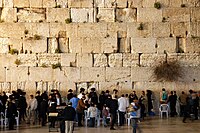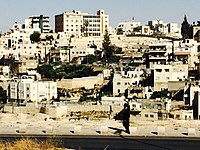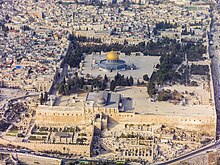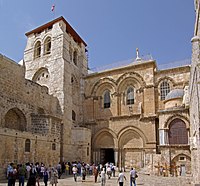Religious significance of Jerusalem
The city of Jerusalem is sacred to many religious traditions, including the Abrahamic religions of Judaism, Christianity and Islam which consider it a holy city. Some of the most sacred places for each of these religions are found in Jerusalem and the one shared between all three is the Temple Mount.[1]
In Judaism[]
Jerusalem has been the holiest city in Judaism and the ancestral and spiritual homeland of the Jewish people since the 10th century BCE.[2] During classical antiquity, Jerusalem was considered the center of the world, where God resided.[3]
The city of Jerusalem is given special status in Jewish religious law. In particular, Jews outside Jerusalem pray facing its direction, and the maaser sheni, revai and First Fruits must be eaten in Jerusalem. Any expansion of the city for these purposes must be approved by the Sanhedrin.[citation needed] Also, when the Temple in Jerusalem was standing, Jerusalem observed special laws regarding the Four Species on Sukkot, and the Shofar on Rosh Hashanah.
And God said: "Take now thy son, thine only son, whom thou lovest, Isaac, and go to the land of Moriah [Jerusalem]; and offer him there for a burnt-offering upon one of the mountains [Temple Mount] which I will tell thee of."
— Genesis 22:2
Jerusalem has long been embedded into Jewish religious consciousness. Jews have studied and personalized the struggle by King David to capture Jerusalem and his desire to build the Jewish temple there, as described in the Book of Samuel and the Book of Psalms. Many of King David's yearnings about Jerusalem have been adapted into popular prayers and songs.
Jerusalem appears in the Tanakh (Hebrew Bible) 669 times and Zion (which usually means Jerusalem, sometimes the Land of Israel) appears 154 times. The first section, the Torah, only mentions Moriah, the mountain range believed to be the location of the binding of Isaac and the Temple Mount in Jerusalem, and in later parts of the Tanakh the city is written explicitly. The Tanakh (or Old Testament), is a text sacred to both Judaism and Christianity. In Judaism it is considered the Written Law, the basis for the Oral Law (Mishnah, Talmud and Shulkhan Arukh) studied, practiced and treasured by Jews and Judaism for three millennia.[4] The Talmud elaborates in great depth the Jewish connection with the city.
According to the Hebrew Bible, the First Temple, at the site known as the Temple Mount today, was built by King Solomon and finished in 950 BC,[5] and Mount Moriah is where Abraham almost sacrificed his son and talked to God. When the Babylonians captured the city in 580 BC, they destroyed the temple and sent the Jews into exile.[6] That is, all worshiping was practiced in the temple and only the temple. From the Babylonian capture, Judaism was codified.[7] The Tanakh (Old Testament) laid the foundation for both Christianity and Islam.

Jews worship at the Western Wall

Member of the Ultra-Orthodox Jewish Community Walking in front of Silwan. Many members of the Ultra-Orthodox Community travel to and live in Jerusalem
In Christianity[]
In Christian faith, Jerusalem's place in the life of Jesus gives it great importance, in addition to its place in the Old Testament. Jerusalem is the place where Jesus was brought as a child, to be "presented" at the Temple (Luke 2:22) and to attend festivals (Luke 2:41). According to the Gospels, Jesus preached and healed in Jerusalem, especially in the Temple courts. There is also an account of Jesus' "cleansing" of the Temple, chasing various traders out of the sacred precincts (Mark 11:15). At the end of each of the Gospels, there are accounts of Jesus' Last Supper in an "upper room" in Jerusalem, his arrest in Gethsemane, his trial, his crucifixion at Golgotha, his burial nearby and his resurrection and ascension.
The earliest Christians were outcast and used the Ichthys fish symbol as a way to know if someone was Christian. This would prevent prosecution or death from the Romans.[8] Christianity became more popular over time, but made a huge expansion when the Roman Emperor Constantine claimed Christianity as his religion and thus the religion of the Roman Empire.[9] Jerusalem is mostly important to Christianity because it is where Jesus Christ was brought occasionally as a child, preached to the poor in his adult life, crucified at the end of his life, and resurrected by God. The Church of the Holy Sepulchre is said to have been built over the location where Jesus was crucified and where the tomb was buried.[10]
In Christianity, the Jewish connection with the city is considered as the account of God's relationship with His chosen people—the original covenant—and the essential prelude to the events narrated in the New Testament, including both universal commandments (e.g. the Ten Commandments) and obsolete or Judaism-specific ones. In medieval times, Christians thought Jerusalem was the center of the world (Latin: umbilicus mundi, Greek: Omphalos), and was so represented in the so-called T and O maps. Byzantine hymns speak of the Cross being "planted in the center of the earth," and the imagery is tied to the concept of the Death and resurrection of Jesus being for the benefit of all mankind. Medieval maps of Europe usually placed the east ("orient")—Jerusalem—at the top, and this arrangement led to the use of the term "to orient" to mean to align a map with actual compass directions.
Main entrance to the Church of the Holy Sepulchre
The Cenacle on Mount Zion, claimed to be the location of the Last Supper and Pentecost. Bargil Pixner[11] claims the original Church of the Apostles is located under the current structure.

Many Christian visitors to Jerusalem come from the American Bible Belt
In Islam[]

Jerusalem is considered a sacred site in Islamic tradition, along with Mecca and Medina. Islamic tradition holds that previous prophets were associated with the city, and that the Islamic prophet Muhammad visited the city on a nocturnal journey (Isra and Mi'raj). Due to such significance, it was the first Qibla (direction of prayer) for Muslims and the prophet Muhammad designated the Al-Aqsa for pilgrimage.[citation needed]
Born in 570 AD, Muhammad is believed by Muslims to be a messenger of God.[12] He reformed the perspective that God should be worshiped through prayer, reciting God's messages and only worshiping God.[13] Muhammad declared himself to be the last prophet of the Judaic-Christian Religions and he founded a third Abrahamic religion: Islam. The Dome of the Rock is an Islamic sacred shrine in Jerusalem, built on the Temple Mount. It is believed this is where Muhammad ascended into heaven and was given the second pillar of Islam, to pray five times a day, from Allah, which is still used today.[14] The Dome of the Rock is influenced by Byzantine Christian architecture, being of a Central Dome Plan.
Glory to He (God) Who did take His servant for a Journey by night from the Sacred Mosque to the farthest Mosque, whose precincts We did bless .
No journey should be undertaken to visit any mosque but three: this mosque of mine, al-Masjid al-Haraam and Masjid al-Aqsa."
The most holy spot [al-quds] on earth is Syria; the most holy spot in Syria is Palestine; the most holy spot in Palestine is Jerusalem [Bayt al-maqdis]; the most holy spot in Jerusalem is the Mountain; the most holy spot in Jerusalem is the place of worship [al-masjid], and the most holy spot in the place of worship is the Dome
Zayd ibn Thabit reports that the Prophet said, "How blessed is al-Sham! The Companions around asked: "Why is that?" The Messenger replied, "I see the angels of Allah spread their wings over al-Sham". lbn Abbas added, "and the Prophets lived in it. There is not a single inch in al-Quds (Jerusalem) where a Prophet has not prayed or an angel not stood".
— Tirmidhi hadith (compiled between 864/5-884)[citation needed]
Muhammad is believed to have been taken by the miraculous steed Buraq to visit Jerusalem, where he prayed, and then to visit heaven, in a single night in the year 610. Jerusalem is not directly mentioned by name in the Qur'an, nor is it mentioned by its Arabic translation (Al Quds). However, the Qur'anic verse (17:1) is interpreted by Islamic tafsirs (commentaries) as referring to this journey, with the term "the farthest Mosque" (al-masjid al-Aqsa) referring to the Noble Sanctuary in Jerusalem, where the mosque stands. There he meets other prophets (in particular, Abraham, Moses, and Jesus).[19]
The Al-Aqsa Mosque is specified of being in Jerusalem as per numerous hadith:
Narrated Jabir bin 'Abdullah: "Then he heard Allah's Apostle saying, "When the people of Quraish did not believe me (i.e. the story of my Night Journey), I stood up in Al-Hijr and Allah displayed Jerusalem in front of me, and I began describing Jerusalem to them while I was looking at it." Sahih Bukhari: Volume 5, Book 58, Number 226.[20]
Part of Jerusalem's significance and holiness to Muslims derives from its strong association with Abraham, David, Solomon, and Jesus. They are all regarded as Prophets of Islam and their stories are mentioned in the Qur'an.
Jerusalem served as the first qibla (direction of prayer) for Muslims. Whilst Muslims were in Mecca, and also for 17–18 months in Medina, Muslims prayed towards Jerusalem. Early mosques in Medina were built to face Jerusalem. In 625, the qibla was changed to the Kaaba in Mecca.[21][Quran 2:142–151]
After Muhammad, many of his Companions lived in Jerusalem, and upon their death they were buried there.[22]
In Mandaeism[]
In Mandaeism (an ancient Gnostic-like non-Christian religion, once significant in numbers but now a small group found primarily in parts of southern Iran and Iraq), Jerusalem is considered a city of wickedness, dedicated to the god of Judaism, whom they call Adunay (Adonai) or Yurba (possibly YHWH) and consider to be an evil spirit. According to Sidra d-Yahia 54, Jerusalem is "the stronghold that Adunay built ... [he] brought to it falsehood in plenty, and it meant persecution against my tarmidia (Manda d-Hiia's disciples)." In the Ginza Rba (15.11), it is said to have come into being as a result of the incestuous union of the seven planets with their evil mother Ruha d-Qudsha, meaning Holy Spirit, who "left lewdness, perversion, and fornication in it. They said: 'Whoever lives in the city of Jerusalem will not mention the name of God.'" (Elsewhere, however, it more prosaically says the city was built by Solomon.) However, Yahya (John the Baptist), an important figure in the religion, is said to have been born there.
See also[]
- Religious significance of the Syrian region
- Holy Land
- Timeline of Jerusalem
- Temple Denial
Notes[]
- ^ “Temple Mount, The.” GoJerusalem.com
- ^ Since the 10th century BCE:
- "Israel was first forged into a unified nation from Jerusalem some three thousand years ago, when King David seized the crown and united the twelve tribes from this city... For a thousand years Jerusalem was the seat of Jewish sovereignty, the household site of kings, the location of its legislative councils and courts. In exile, the Jewish nation came to be identified with the city that had been the site of its ancient capital. Jews, wherever they were, prayed for its restoration." Roger Friedland, Richard D. Hecht. To Rule Jerusalem, University of California Press, 2000, p. 8. ISBN 0-520-22092-7
- "The Jewish bond to Jerusalem was never broken. For three millennia, Jerusalem has been the center of the Jewish faith, retaining its symbolic value throughout the generations." Jerusalem- the Holy City, Israeli Ministry of Foreign Affairs, February 23, 2003. Accessed March 24, 2007.
- "The centrality of Jerusalem to Judaism is so strong that even secular Jews express their devotion and attachment to the city and cannot conceive of a modern State of Israel without it... For Jews Jerusalem is sacred simply because it exists... Though Jerusalem's sacred character goes back three millennia...". Leslie J. Hoppe. The Holy City:Jerusalem in the theology of the Old Testament, Liturgical Press, 2000, p. 6. ISBN 0-8146-5081-3
- "Ever since King David made Jerusalem the capital of Israel 3,000 years ago, the city has played a central role in Jewish existence." Mitchell Geoffrey Bard, The Complete Idiot's Guide to the Middle East Conflict, Alpha Books, 2002, p. 330. ISBN 0-02-864410-7
- "For Jews the city has been the pre-eminent focus of their spiritual, cultural, and national life throughout three millennia." Yossi Feintuch, U.S. Policy on Jerusalem, Greenwood Publishing Group, 1987, p. 1. ISBN 0-313-25700-0
- "Jerusalem became the center of the Jewish people some 3,000 years ago" Moshe Maʻoz, Sari Nusseibeh, Jerusalem: Points of Friction - And Beyond, Brill Academic Publishers, 2000, p. 1. ISBN 90-411-8843-6
- "The Jewish people are inextricably bound to the city of Jerusalem. No other city has played such a dominant role in the history, politics, culture, religion, national life and consciousness of a people as has Jerusalem in the life of Jewry and Judaism. Since King David established the city as the capital of the Jewish state c. 1000 BCE, it has served as the symbol and most profound expression of the Jewish people's identity as a nation." Basic Facts you should know: Jerusalem Archived 2013-01-04 at the Wayback Machine, Anti-Defamation League, 2007. Accessed March 28, 2007.
- ^ Korb, Scott. Life in Year One. New York: Riverhead books, 2010. print, 155. ISBN 978-1-59448-899-3.
- ^ List of Jewish prayers and blessings
- ^ Lacey, Ian. "Judaism as a Religious Tradition - Israel & Judaism Studies" Israel and Judaism Studies.
- ^ "Temple Mount, The," GoJerusalem.com.
- ^ Lacey, Ian. "Judaism as a Religious Tradition - Israel & Judaism Studies" Israel and Judaism Studies.
- ^ "Christian Fish Symbol, The." Religion Facts.
- ^ "One-Page Overview of Christian History, A" Religious Facts
- ^ "Holy Sepulchre." Encyclopædia Britannica. Encyclopædia Britannica Online Academic Edition.
- ^ Bargil Pixner, The Church of the Apostles found on Mount Zion, Biblical Archaeology Review 16.3 May/June 1990 [1]
- ^ "Muhammad." Encyclopædia Britannica. Encyclopædia Britannica Online Academic Edition.
- ^ "Islamic world." Encyclopædia Britannica. Encyclopædia Britannica Online Academic Edition.
- ^ "Dome of the Rock." Encyclopædia Britannica. Encyclopædia Britannica Online Academic Edition.
- ^ IslamQA.info website "Does the multiplied reward for prayers apply only to the mosque of the Ka’bah or does it include the entire Haram (sanctuary)?" IslamQA.info retrieved June 22, 2013
- ^ As quoted in Abu Bakr Muhammad ibn Ahmad al-Wasiti's Fada'il Bayt al-Muqaddas (c.1019)
- ^ Jerusalem for the Three Monotheistic Religions. A Theological Synthesis, Alviero Niccacci Archived 2012-10-08 at the Wayback Machine
- ^ The Ḥaram of Jerusalem, 324-1099: temple, Friday Mosque, area of spiritual power, by Andreas Kaplony, 2002
- ^ Brooke Olson Vuckovic. Heavenly journeys, earthly concerns (2004). Routledge.
- ^ Sahih al-Bukhari, 5:58:226
- ^ Buchanan, Allen (2004), States, Nations, and Borders: The Ethics of Making Boundaries, Cambridge University Press, ISBN 0-521-52575-6, retrieved 9 June 2008
- ^ Significance of Jerusalem to Jews and Christians Archived 2010-06-02 at the Wayback Machine, IslamOnline, July 10, 2002.
References[]
- Ali, Abdullah Yusuf (1991). The Holy Quran. Medina: King Fahd Holy Qur-an Printing Complex.
- Grand Muftis of Jerusalem
- Religion in Jerusalem





